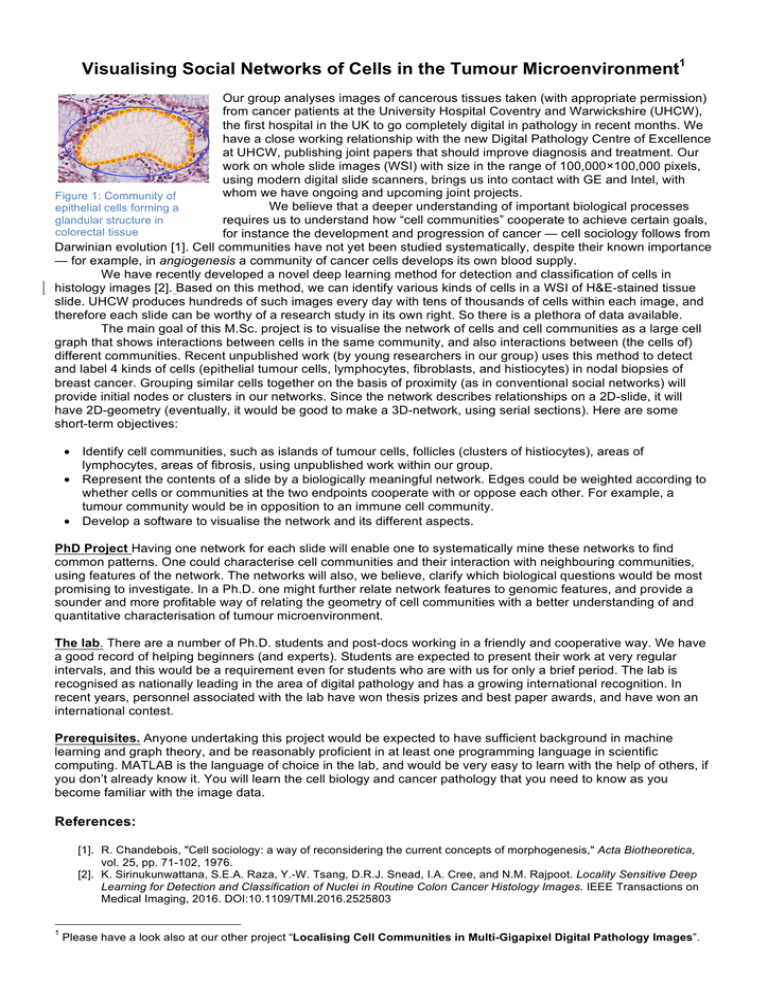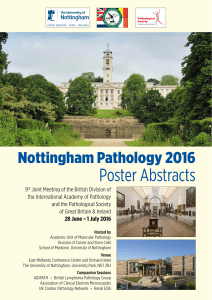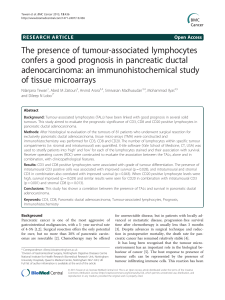Visualising Social Networks of Cells in the Tumour Microenvironment
advertisement

Visualising Social Networks of Cells in the Tumour Microenvironment1 Our group analyses images of cancerous tissues taken (with appropriate permission) from cancer patients at the University Hospital Coventry and Warwickshire (UHCW), the first hospital in the UK to go completely digital in pathology in recent months. We have a close working relationship with the new Digital Pathology Centre of Excellence at UHCW, publishing joint papers that should improve diagnosis and treatment. Our work on whole slide images (WSI) with size in the range of 100,000×100,000 pixels, using modern digital slide scanners, brings us into contact with GE and Intel, with whom we have ongoing and upcoming joint projects. Figure 1: Community of We believe that a deeper understanding of important biological processes epithelial cells forming a glandular structure in requires us to understand how “cell communities” cooperate to achieve certain goals, colorectal tissue for instance the development and progression of cancer — cell sociology follows from Darwinian evolution [1]. Cell communities have not yet been studied systematically, despite their known importance — for example, in angiogenesis a community of cancer cells develops its own blood supply. We have recently developed a novel deep learning method for detection and classification of cells in histology images [2]. Based on this method, we can identify various kinds of cells in a WSI of H&E-stained tissue slide. UHCW produces hundreds of such images every day with tens of thousands of cells within each image, and therefore each slide can be worthy of a research study in its own right. So there is a plethora of data available. The main goal of this M.Sc. project is to visualise the network of cells and cell communities as a large cell graph that shows interactions between cells in the same community, and also interactions between (the cells of) different communities. Recent unpublished work (by young researchers in our group) uses this method to detect and label 4 kinds of cells (epithelial tumour cells, lymphocytes, fibroblasts, and histiocytes) in nodal biopsies of breast cancer. Grouping similar cells together on the basis of proximity (as in conventional social networks) will provide initial nodes or clusters in our networks. Since the network describes relationships on a 2D-slide, it will have 2D-geometry (eventually, it would be good to make a 3D-network, using serial sections). Here are some short-term objectives: • Identify cell communities, such as islands of tumour cells, follicles (clusters of histiocytes), areas of lymphocytes, areas of fibrosis, using unpublished work within our group. • Represent the contents of a slide by a biologically meaningful network. Edges could be weighted according to whether cells or communities at the two endpoints cooperate with or oppose each other. For example, a tumour community would be in opposition to an immune cell community. • Develop a software to visualise the network and its different aspects. PhD Project Having one network for each slide will enable one to systematically mine these networks to find common patterns. One could characterise cell communities and their interaction with neighbouring communities, using features of the network. The networks will also, we believe, clarify which biological questions would be most promising to investigate. In a Ph.D. one might further relate network features to genomic features, and provide a sounder and more profitable way of relating the geometry of cell communities with a better understanding of and quantitative characterisation of tumour microenvironment. The lab. There are a number of Ph.D. students and post-docs working in a friendly and cooperative way. We have a good record of helping beginners (and experts). Students are expected to present their work at very regular intervals, and this would be a requirement even for students who are with us for only a brief period. The lab is recognised as nationally leading in the area of digital pathology and has a growing international recognition. In recent years, personnel associated with the lab have won thesis prizes and best paper awards, and have won an international contest. Prerequisites. Anyone undertaking this project would be expected to have sufficient background in machine learning and graph theory, and be reasonably proficient in at least one programming language in scientific computing. MATLAB is the language of choice in the lab, and would be very easy to learn with the help of others, if you don’t already know it. You will learn the cell biology and cancer pathology that you need to know as you become familiar with the image data. References: [1]. R. Chandebois, "Cell sociology: a way of reconsidering the current concepts of morphogenesis," Acta Biotheoretica, vol. 25, pp. 71-102, 1976. [2]. K. Sirinukunwattana, S.E.A. Raza, Y.-W. Tsang, D.R.J. Snead, I.A. Cree, and N.M. Rajpoot. Locality Sensitive Deep Learning for Detection and Classification of Nuclei in Routine Colon Cancer Histology Images. IEEE Transactions on Medical Imaging, 2016. DOI:10.1109/TMI.2016.2525803 1 Please have a look also at our other project “Localising Cell Communities in Multi-Gigapixel Digital Pathology Images”.



